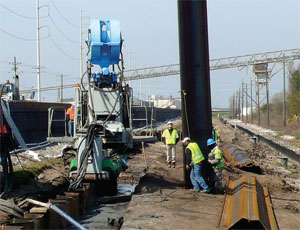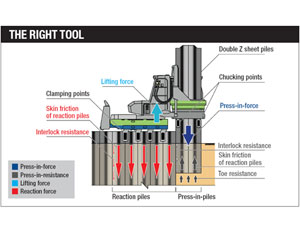A New Orleans contractor tried and failed four times to drive sheet piles through a dense soil layer with progressively larger vibratory hammers and an impact hammer. The fifth attempt is succeeding, thanks to the right tool: a hydraulic press that slides the steel in with great force, rather than banging it down.

In late 2005, as part of emergency repairs after Hurricane Katrina, the U.S. Army Corps of Engineers let a contract to beef up a stretch of concrete I-wall on the Inner Harbor Navigation Canal with, among other things, a sheet-pile wall to block seepage through a sand strata.
But contractors couldn’t drive the sheets. “We tried three differently sized vibratory hammers and then an impact hammer with no success,” says Jerry Whittle, president, Shavers-Whittle Construction Inc., a Covington, La., subcontractor on the first contract.
Vibratory hammers, rated in inch-pounds of eccentric moment force, deliver 65 to 80 tons of downward pressure, says Alan Hunter, the Corps’ Hurricane Protection Office resident engineer.
The contractor started with a 1123 International Construction Equipment vibratory model with 1,100 inch-pounds of force. Then he tried driving Z sheets with an ICE model 2230, with about 2,800 inch-pounds of force. Then he waged a model 4450 with 4,400 inch-pounds. “Still no success,” Whittle says.
Shavers-Whittle then tried a diesel impact hammer, the ratings of which are given in foot-pounds of impact force. The firm used an ICE model 19, which delivers about 43,000 foot-pounds of energy at its highest setting, Whittle says. Progress was about a foot per 100 blows.
“It started to bend the tops of the piles,” Whittle says. Water-jetting helped a little. However, he says, “We started to see shifting of soil, some cracking near the railroad bed, and the Corps suspended the work.”
Now Shavers-Whittle is back on a $2.4-million contract to drive the 1,398 linear ft of 55-ft-long sheet pile to -49.6 ft, but this time with a hydraulic, reaction-based, press-in machine from Giken Seisakusho Ltd., Tokyo. “We had problems before. I would not have bid that job without Giken,” says Whittle. “I wouldn’t have attempted to do it conventionally.”
Mike Carter, corporate manager of Giken’s U.S. construction division, Blue Iron Foundations and Shoring LLC, St. Rose, La., says the Giken achieves down-force-pressure by clamping onto already installed piles and capturing that additional reaction. Capt. Nicholas Cali, Corps project manager, IHNC branch, says the tool is delivering about 98 tons of down-force. Also, Cali adds, because the Giken grips the sheet at the bottom, “You don’t lose energy in deflection.” Giken also is water-jetting at about 4,000 psi to break up compacted soil. An internal auger is there as a backup.
Giken is more accurate than conventional driving, adds Deborah Boyle, senior Corps construction project manager. “Everything is shot from the center line of the existing wall, and there is no being 1⁄32 or 1⁄8 off,” she says. “It’s dead-on.”
Also, adds Carter, because the Giken grips the pile on the front and back edge instead of at the middle, there is no movement and more control.
The Giken also has proven to be much faster than the other methods, which in normal soils would take about an hour or more to drive each pile, says Boyle. “With Giken, we are pressing a pair of sheets in 8 to 11 minutes.”
Shavers-Whittle drove the first pile on Feb. 11. The firm now is 17% ahead of schedule on a mid-April completion.



Post a comment to this article
Report Abusive Comment